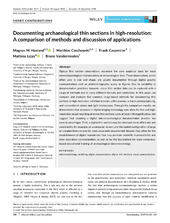| dc.description.abstract | Optical thin section observations represent the core empirical basis for most micromorphological interpretations at archaeological sites. These observations, which often vary in size and shape, are usually documented through digital graphic representations such as photomicrographs, scans, or figures. Due to variability in documentation practices, however, visual thin section data can be captured with a range of methods and in many different formats and resolutions. In this paper, we compare and evaluate five common image‐based methods for documenting thin sections in high‐resolution: a flatbed scanner, a film scanner, a macro photography rig, and conventional stereo and light microscopes. Through the comparison results, we demonstrate that advances in digital imaging technology now allow for fast and high‐resolution visual recording of entire thin sections up to at least ×30 magnification. We suggest that adopting a digital micromorphological documentation practice has several advantages. First, a digital thin section may be observed more efficiently and consistently, for example, on a computer screen, and the spatial configuration of large or complex features may be more accurately documented. Second, they allow for the establishment of digital repositories that may promote scientific reproducibility and inter‐laboratory communication, as well as lay the foundations for more consensus‐based educational training of archaeological micromorphology. | en_US |

